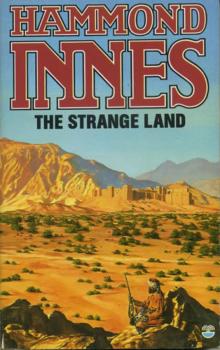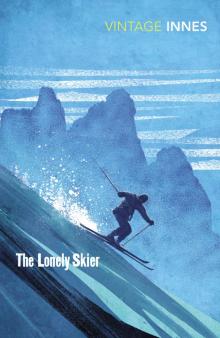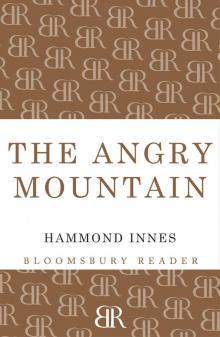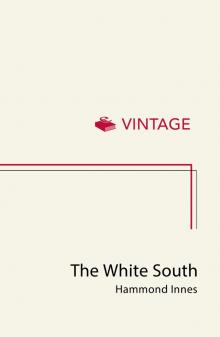- Home
- Hammond Innes
Solomons Seal Page 3
Solomons Seal Read online
Page 3
And that girl – she had spent most of her life out there. Very primitive, wonderfully colourful. I was remembering the way she had said that, the nostalgic whisper of her voice. And now she was free.
If I offered her £500, would that be enough to take her where she wanted to go?
I switched on the light then and spent an hour running through the catalogue, searching for that stamp I hadn’t been able to identify. I had an uneasy feeling that it might be valuable, even though it was spoilt by an ink cancellation; also, it was slightly creased and appeared to have been cut into at the top right-hand corner. I even tried an old Stanley Gibbons World Catalogue, concentrating all the time on the islands of the Pacific, but in the end I had to give it up. I just couldn’t find it. Nor could I identify the proofs, which were printed in black on thick paper and showed what looked like a seal in a rectangular frame and also the frame separately.
It was not until Sunday evening that I was finally able to contact Tubby Sawyer. He had been north along the coast as far as the Deben estuary for a few days, and I called across, inviting him over for a drink, as he drifted up on the tide to his moorings. He was a short, stout man with blue seaman’s eyes in a round, babyish face, and coming alongside in his tiny plastic dinghy, he looked like a frog balanced precariously in the cup of a waterlily. ‘And to what do I owe the doubtful pleasure of being offered a gin on your old Folkboat?’ he asked, squeezing himself in through the hatch and lowering his heavy bottom into the space at the head of the only berth. He wore a tattered blue sweater, oily jeans, and his bare toes were poking out of his salt-stiff deck shoes. ‘First time this season.’ He grinned at me, leaning frayed woollen elbows on the makeshift table. ‘There must be a catch in it.’
‘There is,’ I said. ‘I want you to value some stamps for me.’
‘Free of charge, I suppose.’
‘Of course.’ And I explained about Miss Holland’s circumstances as I poured him his pink gin.
‘Any particular period?’
‘Victorian, most of them.’ I gave him his drink and put the albums down in front of him. ‘See what you think. There’s one I haven’t been able to identify, and where there’s just one stamp to the page like that, it makes them look important even if they aren’t.’
He sat there for a moment gazing at the worn leather covers with their gilt fastenings. These are the sort of albums Victorian ladies used for drawing miniatures, writing poems, pressing flower collections, that sort of thing.’
I poured myself a drink and watched him as he opened first one, then the other, leafing quickly through the loose pages. ‘You’re right about the period, anyway. The end of Queen Victoria’s reign, most of them stamps in issue in the late eighteen hundreds, and all of them stuck down tight.’ He shook his head sadly. ‘Still, it’s probably better than if they were hinged with gummed strips from the sheet margin, a very common practice in those days.’ He turned to the island album and began going through it slowly, page by page, until he came to the blue stamp with LMCL below the ship. He paused there and sipped his drink. ‘This the one you couldn’t identify?’ And when I nodded, he said, ‘Try Trinidad. The “Lady McLeod”. Its value may surprise you.’
I sat down on the berth opposite him, watching his face, which was lit by the evening sun slanting in through the open hatch. He was turning the pages again, and I couldn’t be sure from his expression whether the stamp would put the collection beyond my reach. He came to the end and lit a cigarette, leaning back, his eyes half closed. ‘Well?’ I asked.
‘Don’t be so impatient. I haven’t finished yet.’ He smiled. ‘But it’s interesting – very. I’ll tell you why in a minute.’ And he leaned forward again and began working his way through the second volume. It was so quiet on board I could hear the ticking of the ship’s clock and the gurgle of the tide making against the bows. And then, when he came to the proofs, he held the two loose leaves up to catch the light, peering at them closely. ‘Do you use a magnifying glass when you’re charting?’
‘Yes, do you want it?’
‘Please.’
I found it for him, and he went over those last two pages again, examining the proofs through the glass. ‘Know anything about the person who put this little collection together?’ He seemed quite excited.
‘A little,’ I said. ‘But I’d rather hear what you think first.’
He hesitated, the corners of those bright blue eyes crinkling. ‘Want me to stick my neck out, do you? All right, but tell me something first. This client of yours who’s had such a poor time of it, does she want to sell, or don’t you know yet?’
‘I think that would depend on the price,’ I said cautiously.
He laughed. ‘I never doubted you were a good agent, Roy, but don’t get too excited. We’re not dealing with the earlies here, no Mauritius or other rarities, except for the “Lady McLeod”. Put it this way, is she after a quick cash sale, or is she going to send them to auction? You can tell me that, surely.’ And he added, ‘At auction, as you very well know, it could take four months, even longer, before she got her money.’
‘Are you interested in them personally, then?’ I hadn’t expected that.
He hesitated, then said, ‘Yes. Yes, I think I might be. Not because of the value of the stamps, but because of the collection as a collection. It has a distinct curiosity value.’
‘How do you mean?’
‘You’ve looked through it. Didn’t anything strike you?’
I nodded. ‘New Zealand and those Australian states, you’d expect a man living somewhere in the South Pacific to collect them. But there are Canadian provincials as well, a lot of Newfoundland. And most of them unused, so it looks as though he visited the eastern seaboard of Canada, maybe traded there.’
‘It’s possible.’ But he sounded doubtful. ‘My guess is he simply wrote for them so that he could see what they were like.’ He picked up the last two pages and turned them round so that I could see them. ‘Know what these are?’
‘Proofs,’ I said. ‘But it did occur to me they might be fakes.’
‘Look again.’ And he pushed one of the pages towards me.
I bent forward, examining once again the two little rectangles of thick yellowish paper, one showing the frame of the stamp, the other simply the unadorned shape of what looked like an Arctic or North Atlantic seal. On the other page there was just the one rectangle of paper showing the seal inside the frame. ‘Doesn’t anything strike you now?’
I shook my head. There was no value given, no indication of country, the frame surround all black.
He turned the pages round, lost in thought as he stared down at them. ‘I’m not quite sure if they’re die or plate proofs. That’s why I wanted the magnifying glass. The whole process, as you know, starts with the die, and it is from this original picture, engraved on the flat, that the roller impression is taken by rocking it back and forth over the die under pressure. This transfer, or roller die, is then used to transfer the impression, again by rocking back and forth, on to the actual plate from which the final stamp will be printed. Now, I think these are die proofs. That’s to say, they’re taken from the original flat engraving; in the case of the one showing the seal inside the frame, both dies have been used on the same sheet of paper, the proofs being struck off singly. They have that extra sharpness. If they were plate proofs, they would have been taken from the plate itself after it had been hardened for printing the full sheet of stamps.’ He leafed back through the album, pausing several times. Finally he turned again to the pages with the proofs. ‘Very interesting,’ he mused. ‘The collection itself, I mean. As you say, no Queen’s heads. The stamps are all of ships and views, with a sprinkling of animals. Recess or line-engraved printing, mostly Perkins Bacon, the first printers of postal labels and specialists in line-engraving for banknotes.’
He leaned back, and I guessed I was in for one of his lectures. He loved giving tongue on the printing of stamps, and though he could be very interesti
ng on the subject, he always talked as though the other person knew nothing at all about it. ‘Perkins Bacon now. They produced the Penny Blacks of 1840, all our early stamps, the Penny Reds and Twopenny Blues. Then De La Rue took over, printing by the letterpress process – surface printing. Not nearly as attractive, and the colours harder. So anybody collecting stamps in the ordinary way at the turn of the century would almost certainly have included some of the early line-engraved GBs.’ He picked up his glass, which was empty, and held it out to me. ‘While you’re pouring another drink, you might fill me in on the background, or didn’t you ask her?’
‘About the man who made the collection?’
He nodded. ‘Carlos Holland. Was that his name? It’s on the flyleaf of each album.’
‘Why do you want to know about him?’ I asked. ‘It can’t make any difference to the value of the stamps surely.’
‘I’m curious, that’s all. This isn’t an ordinary collection. I think he put it together because he was exploring design possibilities before ordering stamps he required for his own official use. He was probably a colonial governor, somebody like that.’
‘And the die proofs at the end represent the design of his choice, is that what you’re saying?’
‘Yes, that’s about it.’
‘Well, I can tell you this, he wasn’t a colonial governor.’ I reached for the gin bottle and the Angostura. ‘But you’re right about the name.’ And I passed on to him what little I had been told about Carlos Holland.
‘So the ship was a total loss. It went down with all hands.’
‘That’s what I understand.’
‘Then he couldn’t have had this collection with him at the time. If he had, it would be at the bottom of the sea. So how did it come into Miss Holland’s possession?’
‘As I understand it, the albums were among her brother’s things when he was invalided home.’
‘How did he come by them?’
‘I’ve no idea.’
‘Didn’t you ask her?’
‘No.’
‘Very odd,’ he murmured, shaking his head. ‘This man Carlos Holland leaves a collection of carvings with his brother, but not the stamps. And then, somewhere on his way out to the Pacific, at some port of call, he suddenly decides to leave these albums ashore. And there’s something else,’ he said, gazing abstractedly at the albums. ‘What about the sheets?’
‘Sheets?’
‘Yes, the sheets,’ he said almost irritably. ‘The printed sheets of the final stamp.’ He looked up at me over his tumbler. ‘You say he owned some schooners and came back to England to add a steamship to his fleet. That suggests he required stamps for the franking of mail carried in his vessels. So where are the sheets?’
‘Presumably at the bottom of the sea.’
He nodded, but I could see he was not wholly convinced. ‘Very odd,’ he said again. ‘And the design … I can only recall having seen two ship stamps, and like the “Lady McLeod” stamp, they both carried the picture of the ship. This stamp doesn’t; the picture enclosed in the frame is of a seal. Doesn’t that strike you as odd?’
The collection includes quite a few stamps with ships on them.’
‘Exactly. And he chooses a seal as his emblem. Seals don’t swim around coral reefs in the warm waters of the South Pacific. Not the grey or Atlantic seal, which I think this is.’ He gave a little sigh. ‘Pity the girl isn’t here to answer a few questions.’
‘I don’t think she’d be able to help you. She didn’t seem to know very much about the stamps. All she said was that they were among Timothy Holland’s things when he arrived back in England and that another brother, Jona Holland, wrote that he’d been very excited by the find.’
He nodded. ‘Well he might be if he knew anything about stamps.’ He was silent for a while, sitting there staring at the black impression of the proof. ‘But no sheets,’ he muttered. ‘I wonder …’ He sat back, toying with his glass. ‘If I’m right, then there must have been sheets of those stamps. I wonder where they are. Somebody must have them.’ He shrugged, closing the album slowly and with a certain reluctance. ‘I think I’d better take this collection along to somebody who knows more about ship stamps than I do. Josh Keegan is the best bet. And if he doesn’t know, he’ll tell me who to go to. I’ve a feeling … I’m not sure, mind you, but I think a stamp rather like that die proof came up for sale at a Robson Lowe auction some years back. Josh may have been at the sale.’ He downed the rest of his drink and got to his feet. ‘I’ve got to go now. Mind if I take the albums with me?’
I hesitated, unwilling to let them go now that I knew he was interested. ‘Yes, of course,’ I said. Obviously he couldn’t give me a valuation on the spot.
‘Good.’ He had noticed my hesitation and smiled. ‘Don’t worry. I’ll take good care of them.’ He picked up the albums, holding them out to me. ‘Pop them in a polythene bag, will you? Don’t want to get them wet rowing ashore.’
He had a supper date with friends near Maldon and when he had seated himself carefully in his dinghy he looked up at me, his bright eyes twinkling. ‘I could have valued the collection off the cuff, made you an offer, and, given the girl’s circumstances, she’d probably have accepted. Instead, I’m seeking expert opinion for you. Greater love hath no man.’ He picked up the oars, and as I tossed the painter into the bows, he began to drift away on the tide. ‘I’ll tell Josh to ring you direct if he’s anything of interest to report. Otherwise, I’ll come back to you myself and make an offer for the lot.’
‘You really want it then?’
He nodded, smiling at me like an amiable frog. ‘Yes, I do. First time I’ve ever had a collection in my hands that was made for the purpose of choosing a design. Three or four days and I’ll hope to be back to you with that offer.’
‘Well, see that it’s a fair one,’ I said.
He laughed, back-paddling against the tide, the plastic dinghy so low in the water it looked on the verge of sinking. ‘Suspicious bastard you are. Whatever the business ethics in your world, Roy, stamps are still a gentlemanly occupation.’ And with that he swung the little boat round and headed for the nearest landing pier.
As soon as I was home, I got out the catalogue and looked up Trinidad. There it was, the first Crown Colony stamp listed, a 5c. blue. A note underneath read: The ‘Lady McLeod’ stamps were issued in April, 1847, by David Bryce, owner of the s.s. Lady McLeod, and sold at five cents each for the prepayment of the carriage of letters by his vessel between Port of Spain and San Fernando. Used examples are pen-cancelled or have a corner skimmed off. The value of it unused was given as £6,000, used £2,000.
I sat there staring at it for a long time. Even though the Holland stamp was used, or rather pen-cancelled, and the condition of it not that good, it put the collection in a different class, quite outside my range. To buy it, I’d have to sell most of my carefully acquired GB stamps. Either that or the boat.
I put it out of my mind after that, which wasn’t difficult since I was loaded with all Packer’s work. And on top of that Rowlinson sent me the figures for Munnobungle, asking me for my comments as soon as possible.
It was not until the following Friday that I heard from Tubby, a formal letter that read:
Dear Mr Slingsby,
I have now gone through the whole collection with a view to valuation. Excluding the ‘Lady McLeod’ and the die proofs on the last two pages, the theoretical value is £1,273 based on the latest Stanley Gibbons catalogue. Bearing in mind their condition, my estimate of the actual value is around £500 – at auction they might well reach a little more, equally they might fetch less.
The value of the die proofs is impossible to estimate. A copy of the actual stamp does exist, in deep blue, but it did not go through the post in the normal way. It was apparently on a cover (i.e., envelope) which bore an Australian postage-due stamp. In other words, the Australian postal authorities refused to accept it, regarding it as no more than a private label. This cover was so
ld at a Robson Lowe auction about two years ago for £220, a high price considering it’s an unknown and so had curiosity value only. Josh was at the sale and recalls that it was bought by a dealer handling European accounts. In the circumstances, I think it fair to value the die proofs at the same figure.
As regards the ‘Lady McLeod’ Trinidad ship stamp, this is more difficult to set a value on. In prime condition the current value of a pen-cancelled example is put at £2,500. What this particular example would fetch at auction is anybody’s guess, but Josh was quite prepared to give £550 for it, so I think £600 would be a fair valuation.
Thus, my valuation for the two albums is £1,320 and, as agreed, there is no charge for this.
I think it would be a great pity to break this collection up and sell the stamps piecemeal. I remain personally interested in it as a curiosity and am prepared to offer £1,500 for the collection as it stands. Perhaps you would convey this offer to Miss Holland. I do not honestly think she will do better than this, and I will keep the albums here in my safe until I hear from you.
No sailing this week-end. I promised to go down for my son’s half-term.
Sincerely,
J. L. SAWYER
I did something then on the spur of the moment that was pretty daft. I wrote to Miss Holland telling her that I was enclosing Commander Sawyer’s letter valuing the stamps and offering for them. And then I added that I was personally interested as a collector and asked if I could drive over and see her as I might be able to offer her slightly more. To this day I don’t know how much I was motivated by my interest in the collection, how much by my desire to see her again, and it was only after the letter had gone that I began to worry about raising the cash. But if Rowlinson did decide to offer me the job in Australia, I would be selling the boat anyway, and that would more than cover it.
Almost a week passed, and no word from Miss Holland, nothing from Rowlinson, though I had sent him an outline of my ideas for halting the losses on his Queensland property. And then, after a deadly dull morning arguing with bureaucrats and tenants over rent increases for a row of tenement houses, I returned to the office to find that Rowlinson’s secretary had phoned to say he would call at my home at 7 p.m. Also, Eric Chandler had been trying to get me. The only business we had with Rose, Walker &c Chandler at that moment was The Passage valuation and sale of contents, and when I rang him back to point out that I had sent my rough estimate of the current value of the house the previous week, he said, ‘Yes, of course, and that’s all being dealt with.’ He had a high-pitched East Anglian voice. ‘But now we need her signature, and she’s disappeared. I wondered whether you could help me. You met her, I take it, when you did the valuation?’

 High Stand
High Stand The Doomed Oasis
The Doomed Oasis Golden Soak
Golden Soak Levkas Man (Mystery)
Levkas Man (Mystery) The Strange Land
The Strange Land Dead and Alive
Dead and Alive Attack Alarm
Attack Alarm The Strode Venturer
The Strode Venturer Campbell's Kingdom
Campbell's Kingdom North Star
North Star The Wreck of the Mary Deare
The Wreck of the Mary Deare The Lonely Skier
The Lonely Skier The Black Tide
The Black Tide The Trojan Horse
The Trojan Horse Medusa
Medusa Air Bridge
Air Bridge Maddon's Rock
Maddon's Rock The Angry Mountain
The Angry Mountain Wreckers Must Breathe
Wreckers Must Breathe Solomons Seal
Solomons Seal The White South
The White South